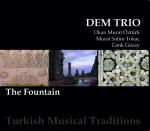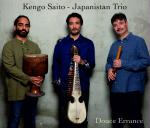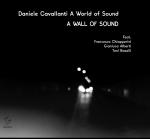

DEM TRIO
The Fountain - Turkish Musical Traditions
Fy 8133
8021750813322
Felmay Records
Turchia
The Fountain - Turkish Musical Traditions
Fy 8133
World Music
8021750813322
Felmay Records
Turchia
Uno sguardo profondo e ben documentato su taluni aspetti fondamentali della musica turca è quanto propone il DEM TRIO in The Fountain. Formato dai polistrumentisti Okan Murat Öztürk, Murat Salim Tokaç e Cenk Güray, il trio ha condotto importanti ricerche nella regione Anatolica e allo stesso tempo ha studiato e ripreso brani composti da autentici maestri della tradizione classica quali ad esempio Cemil Bey (1871-1916).
La struttura di ogni pezzo sottostà a particolari regole di composizione, che nel loro insieme prendono il nome di makan e forniscono la base per produrre temi e melodie. La parte dell’invenzione vera e propria è pero affidata alle improvvisazioni (taksim), le quali rivestono una particolare importanza e determinano la validità o meno del brano eseguito. In genere esse forniscono una sorta di preludio a una suite oppure la “interrompono” di tanto in tanto. Come si potrà notare ascoltando con attenzione The Fountain, il genere proposto dal DEM TRIO si avvicina a ciò che potremmo definire, in termini occidentali, “musica da camera”, con i solisti che si alternano nel proporre un’elaborazione della melodia e delle linee ritmiche per poi procedere a loro piacimento nelle improvvisazioni.
Anche l’uso di una particolare strumentazione caratterizza la musica proposta dal DEM TRIO. Nello specifico occorre notare come sia il tanbur (strumento simbolo della musica d’arte suonata un tempo a corte e nei palazzi nobili) sia il tanbura (strumento della musica folk) siano utilizzati insieme, nell’intento di voler ritrovare una comune origine per le due anime della musica turca. Si tratta di strumenti a corde apparentabili alla famiglia dei liuti, ma che non vanno confusi con l’oud di tradizione araba, pur se tutti appartengono e derivano da un comune ceppo mediorientale. Altri strumenti a corde impiegati sono il baglama, il lavta e il cümbüs (che dispone di una cassa di risonanza ricoperta in pelle), mentre tra i fiati troviamo il ney, il cui suono evocativo ricorda quello del duduk armeno.
Grazie alle scoperte a cui ci introduce il DEM TRIO possiamo entrare in un rapporto vivo e palpabile l’antica cultura ottomana risolta però attraverso un’interpretazione contemporanea, tesa anche a mettere in luce i legami esistenti tra il patrimonio musicale turco e quello delle regioni limitrofe (Grecia, Balcani, l’area mediorientale).


Okan Murat Öztürk - baglama, tanbura, lavta, cumbus, voce
Murat Salim Tokaç - tanbur, ney
Cenk Güray - fretless baglama, divan sazi
Ospiti
Nursah Acun - voce

Le nostre Playlist
La nostra playlist su spotify Pre Minimalismo, minimalismo e post minimalismo, brani dal nostro catalogo curati per noi da Federico Marchesano,
© 2025 Felmay Srl - P.I. 06974300011 | Powered by: Riccardo Marino

























